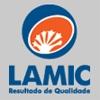INTRODUCTION
Fumonisins are secondary metabolites of Fusarium verticilloides and were first isolated and chemically characterized in 1988 (Gelderblom et al. 1988). About 28 homologues have been discovered since then. However, from a toxicological standpoint, Fumonisin B1 (FB) is the most common and studied homologue. Others, such as FB2 , FB3 , and FB4 are less prevalent (Voss et al. 2007). FB prevalence in Brazilian corn is 62% (out of 13,756 samples) under an average 1.2mg/kg contamination on the last 11 years (Mallmann et al. 2010). The chemical structure of FB is similar to that of the sphingoid bases (sphinganine and sphingosine) and the main mechanism of action proposed is that FB inhibits the ceramide synthase enzyme, blocking the sphingoid turnover. This inhibition of ceramide synthase leads to an accumulation of sphingoid bases (mainly sphinganine) which exert proapoptotic, citotoxic, and growth inhibitory effects. So, the sphinganine-to-sphingosine ratio (SA:SO) is the most sensitive biomarker to FB intoxication in many animal species (Voss et al. 2007). Two important animal diseases/syndromes are currently associated to Fumonisin B1 (FB) contamination in feed: the equine leukoencephalomalacia (Marasas et al. 1988) and the porcine pulmonary edema (Harrison et al. 1990). Some researches point out that FB is involved in some cases of human cancer, such as esophageal (Dragan et al. 2001) and liver (Ueno et al. 1997) cancers. It is well known that FB causes losses when contaminated feed is provided to broilers (Kubena et al. 1997, Li et al. 1999, Henry et al. 2000, Broomhead et al. 2002, Del Bianchi et al. 2005), however, there is no consensus on which variables FB impacts. The objective of this research was to evaluate the clinical response of broiler chickens receiving 3 different doses of Fumonisin B1 in the diet, from 1 to 28 days of age. Clinical variables evaluated included performance, serum biochemistry, acute phase protein levels, sphinganine-to-sphingosine ratio, histopathological changes, and morphologic evaluation of small intestine.
MATERIALS AND METHODS
Experimental animals and protocol. One hundred and ninety-eight one-day-old Cobb commercial male broiler chickens were divided into 3 treatments with 6 replicates each, with 11 birds in each replicate. Birds were kept in 18 electrically heated, wired floor cages, from day 1 to 28. Temperature and humidity were controlled via air-conditioners and exhausters and a 24-hour lighting program was applied throughout the entire experiment. The protocol applied to this experiment, including sample collection methods, was reviewed and approved by the Ethics Committee on the Use of Animals on Research of the Federal University of Rio Grande do Sul (Proc. 19847).
Experimental diets. A corn and soybean meal-based basal diet was formulated to meet the standard nutritional requirements of broilers in initial phase (NRC 1994). Birds received experimental diets from day 1 to 28, and feed was provided ad libitum. To reach the desired FB contamination in the feed (0, 100, or 200mg/kg of feed), a Fusarium verticilloides (strain MRC 826) culture material (FCM) containing 5,715mg of FB1 /kg was incorporated into the diet. This FCM was obtained according to a procedure previously described (Dilkin et al. 2002). The diet also contained a certain amount of Fumonisin B2 (0, 20, and 40mg/kg of each feed), considered to be a less toxic metabolite of F. verticilloides (Kubena et al., 1995). Before the beginning of the experiment, the basal diet was screened for the presence of mycotoxins (aflatoxins [B1 , B2 , G1 and G2 ], fumonisins [B1 and B2 ], zearalenone, ciclopiazonic acid, and trichothecenes [deoxynivalenol, 3-acetyl- -deoxynivalenol, 15-acetyl-deoxynivalenol, diacetoxyscirpenol, nivalenol, fusarenone-X, T-2 toxin, and HT-2 toxin) according to Monbaliu et al. (2010). All results were below the detection limits of the methods applied. In addition, diets were analyzed after FCM was incorporated, to confirm the FB concentration. Results were according to the doses established above.
Performance evaluation. At the beginning of the experiment, all birds were individually weighed to determine the homogeneity of the groups. The average body weight was 46.94 g and there were no differences between groups (P=0.69). At 14 and 28 days of experiment, birds were individually weighed for performance evaluation. At the same check-points feed intake and feed conversion rate were calculated to each replicate. Birds were inspected twice a day for clinical signs of FB intoxication and mortality.
Sample collection. At 14 days of experiment, 18 broilers from each treatment (3 per replicate) were euthanized by cervical dislocation after carbon dioxide desensitization for blood collection. The relative weight of liver was calculated and sample of organs were collected for histological evaluation (thymus, bursa of Fabricius, spleen, heart, liver, pancreas, intestine, kidney, and lungs). The number of samples taken from each treatment was: blood = 18 samples; organs = 6 samples; and liver for relative weight calculation = 18 samples. The same procedure was used at 28 days of experiment. Blood samples were centrifuged 30 min after collection and serum was stored at -20ºC until analysis. Organ samples were collected in 10% neutral buffered formalin for histopathological evaluation and processed for hematoxylin and eosin staining (Luna 1968). Additionally, at 28 days of experiment, 54 samples (18 per treatment) of small intestine (jejunum) were collected for morphologic evaluation. Samples were collected and processed using the same procedure applied for samples to histopathological evaluation. After stained, measurements of villus height and crypt depth were taken using the Motic Image Plus 2.0 software (Motic China Group Co. Ltd 2007) according to procedure previously described (Thompson & Applegate 2006).
Serum sample analysis. Serum samples were analyzed for total plasma proteins (TPP), albumin (Alb), total cholesterol (Chol), triglycerides (Tri), calcium (Ca), phosphorus (P), uric acid (UA), and C-reactive protein (CRP) levels, alanine aminotransferase (ALT), aspartate aminotransferase (AST), gamma glutamyltransferase (GGT), and alkaline phosphatase (AP) activity, using commercial kits (Labtest Diagnostica S.A., Vista Alegre, Lagoa Santa, Minas Gerais, Brazil) in a spectrophotometer. Additionally, free sphinganine and sphingosine levels in serum were analyzed for sphinganine-to-sphingosine ratio (SA:SO) calculation, according to Rauber et al. (2012).
Statistical analysis. All data obtained in this experiment were submitted to linear simple regression analysis according to the levels of FB applied. Variables that showed a significance level equal to or higher than 90% (P ≤ 0.10) in this procedure were submitted to analysis of variance (one-way ANOVA) and means were compared by Bonferroni’s multiple range test (P≤0.05). Analyses were done in Statgraphics Centurion computer statistical software (Statgraphics Centurion 15.2.14, Manugistics Inc., Rockville, MD, USA).
RESULTS AND DISCUSSION
Clinical signs and mortality
Clinical signs of FB intoxication were not observed in this study, which is in disagreement with previous reports (Henry et al. 2000, Hoerr 2003, Mallmann et al. 2009). In addition, bird mortality did not occur in the present experiment. According to Mallmann et al. (2009), birds in experimental conditions are submitted to an almost ideal environment and those situations of stress (temperature, air quality, microbiological challenges, etc) that can compromise broilers performance are fully controlled.
Performance
All performance results measured in this experiment were significantly affected (Table 1) by the presence of FB in broilers feed after 28 days. Both body weight (BW) and feed intake (FI) were reduced (P < 0.01) as the inclusion of FB was increased. The reduction on BW and FI in broilers receiving FB was observed at 14 and 28 days of experiment. Feed conversion rate (FCR) was also affected by the presence of FB in the feed. However, a significant effect was only observed at 28 days of experiment (P=0.02), and FCR values were increased in birds receiving FB contaminated feed.
Similar results have been previously described in broilers receiving FB in doses ranging from 10 to 400 mg/kg of feed (Ledoux et al. 1992, Kubena et al. 1997) and the effects were observed after 14 days of exposure. FCR is directly affected by changes in BW and FI. In this research, the reduction on BW gain in broilers receiving FB contaminated feed was more severe than the reduction on FI, resulting in increased values of FCR. The reduction on BW can be partially explained by the reduced FI, but it can also be due to changes in intestinal morphology (reducing nutrients digestibility) and to the effect of FB on liver metabolism (Kubena et al. 1997; Voss et al. 2007).
Serum analyses
Results from serum analyses are presented in Tables 2 to 5. Serum levels of TPP, Ca, Chol, and Tri, and serum activity of ALT, AST, and GGT were increased in broilers receiving FB contaminated feed at both 14 and 28 days of evaluation. Serum levels of Alb, P, and CRP and the SA:SO ratio were increased by the presence of FB in broilers feed only at 28 days of experiment. Serum levels of UA were increased at 14 days of experiment and reduced at the 28 days. No significant effect (P > 0.10) of FB was observed in AP activity in the serum.
Increased levels of Chol and Tri and increased activity of AST and GGT are generally associated with liver damage (Harr 2002, Lumeij 2008), and were observed in this experiment. Increased levels of UA and P indicate kidney lesions whilst reduced UA levels are usually observed in liver damage cases (Hochleithner 1994). According to Voss et al. (2007), FB main target organs are liver and kidney. Ledoux et al. (1992) and Kubena et al. (1997) described similar results for AST and Chol levels in FB poisoned broilers.
Protein (TPP and Alb) levels in broilers receiving hepatotoxic substances are often decreased (Hochleithner 1994). However, some in vitro investigations on the effect of FB on endothelial cells from porcine pulmonary artery indicated that this mycotoxin induces an increased permeability on the endothelium for Alb and other proteins (Ramasamy et al. 1995). In addition, in vivo studies have demonstrated this effect on TPP and Alb levels in the serum of FB poisoned broilers (Kubena et al. 1997). Increased levels of Ca are generally associated with hyperalbuminemia (Hochleithner 1994, Lumeij 2008). The enzyme ALT is distributed among several tissues in broilers and has poor diagnostic value. In general, increased ALT activity in serum indicates non specific cell damage (Hochleithner 1994).
Table 1. Performance of male broiler chickens fed fumonisin B1 contaminated feed during 28 days
Table 2. Relative weight of liver, serum levels of total plasma proteins and albumin in male broiler chickens fed fumonisin B1 contaminated feed during 28 days
Table 3. Serum levels of calcium, phosphorus, and uric acid in male broiler chickens fed fumonisin B1 contaminated feed during 28 days
Table 4. Serum activity of alanine aminotransferase, aspartate aminotransferase, and gamma glutamyltransferase in male broiler chickens fed fumonisin B1 contaminated feed during 28 days
Table 5. Serum levels of total cholesterol, triglycerides, sphinganine-to-sphingosine ratio and serum levels of C-reactive protein in male broiler chickens fed fumonisin B1 contaminated feed during 28 days
Due to its structural similarity to the sphingoid bases sphinganine (SA) and sphingosine (SO), FB competitively inhibits the enzyme ceramide synthase, and as an immediate result, an accumulation of the substrates SA and, to a lesser degree, SO occurs in tissues, serum, and urine (Voss et al. 2007). The biological response for this mechanism is an increase in SA:SO. Similar effects on SA:SO to the ones observed in this experiment have been previously reported in several species, including broilers (Henry et al. 2000; Broomhead et al. 2002, Tran et al. 2003).
Regarding to CRP, its major function is to bind to foreign pathogens and damaged host cells to initiate their elimination. It is an important acute phase protein and its serum levels increase in response to a variety of bacteria and intracellular antigens of damaged cells (Chamanza et al. 1999, Juul-Madsen et al. 2008). An indirect consequence of ceramide synthase enzyme inhibition by FB is to stimulate either mitosis or apoptosis (Dragan et al. 2001, Voss et al. 2007) leading to a condition where an inflammatory response is required.
Pathological findings
The relative weight of liver (RWL) was significantly increased in broilers receiving FB contaminated feed in both evaluations (14 and 28 days). Evaluation of morphologic changes in the small intestine revealed a significant reduction on villus height (VH) and villus-to-crypt ratio (V:C), but no changes in crypt depth (CD) in broilers receiving FB. Histopathological lesions were found only in liver and kidney (no significant lesions were found in heart, lungs, thymus, bursa of Fabricius, spleen, and pancreas) in both evaluations (14 and 28 days). In the liver, main alterations observed were hyperplasia of biliary ducts, hepatocellular degeneration, lymphoid hyperplasia, and proliferation of biliary ducts (Fig.1), while in kidney the only observed lesion was necrosis on the tubular epithelium (Fig.2). Lesions in the liver appear to be the same, regardless the dose of FB used, while the lesions in the kidney appear to be more severe in those birds that received the highest dose of FB. Lesions observed in kidney and liver were present at both evaluation periods (14 and 28 days).
Table 6. Measurements of villus height, crypt depth, and villus-to-crypt ratio at 28 days of age in male broiler chickens fed fumonisin B1 contaminated feed
Fig.1. (A) Histological section of liver from 28 days old broilers from control group and (B) receiving 200mg/kg of Fumonisin B1 . Black arrows in B indicate discrete multifocal proliferation of biliary ducts. HE, obj.20x.
Fig.2. (A) Histological section of kidney from 28 days old broilers from control group and (B) receiving 200mg/kg of Fumonisin B1 . Black arrows in B indicate discrete multifocal tubular necrosis. HE, obj.20x.

Significant amounts of FB are found mainly in the gastrointestinal tract, liver, and kidney and the lesions in these tissues cause most of the clinical and pathological effects of FB intoxication (Ueno et al. 1997, Dragan et al. 2001, Voss et al. 2007). The effects observed in this study on RWL and histological changes in the liver and kidney show that these are the main target organs of FB in broilers like previously described (Ledoux et al. 1992; Kubena et al. 1997, Henry et al. 2000, Del Binachi et al. 2005), turkeys (Kubena et al. 1995), and in pigs (Harrison et al. 1990). In the small intestine, crypts are responsible for the turnover of villus cell while villi are responsible for nutrient absorption. High villus means larger absorption surface, and flat crypts mean normal cell turnover on villus. Both are desirable, and this relation is expressed by high V:C (Gao et al. 2008). FB causing reduction on VH has been previously described in pigs (Dilkin et al. 2004). The change on FCR observed in this study can be partially explained by the reduction on V:C ratio.
CONCLUSIONS
According to the results obtained in this experiment, FB is an important mycotoxin in broiler production, having its effects on several clinical and pathological variables.
The main target organs are liver and kidneys, but the small intestine is also affected, leading to some performance losses, mainly on feed conversion rate. In these experimental conditions, FB causes negative effects on some biological responses and performance of broilers at a dose of 100mg/kg of feed as early as 14 days of intoxication.
Acknowledgements.- To thank Prof. David Driemeier and his staff at the Laboratory of Veterinary Pathology (UFRGS) for histological evaluations.
This article was originally published in Pesquisa Veterinária Brasileira, 33(9), 1081-1086. https://dx.doi.org/10.1590/S0100-736X2013000900006. This is an Open Access article distributed under a Creative Commons Attribution License.
REFERENCES
Broomhead J.N., Ledoux D.R., Bermudez A.J. & Rottinghaus G.E. 2002. Chronic effects of Fumonisin B1 in broilers and turkeys fed dietary treatments to market age. Poult. Sci. 81:56-61.
Chamanza R., Veen L., Tivapasi M.T. & Toussaint M.J.M. 1999. Acute phase proteins in the domestic fowl. World’s Poult. Sci. J. 55:61-71.
Del Bianchi M., Oliveira C.A.F., Albuquerque R., Guerra J.L. & Correa B. 2005. Effects of prolonged oral administration of Aflatoxin B1 and Fumonisin B1 in broiler chickens. Poult. Sci. 84:1835-1840.
Dilkin P., Mallmann C.A., Almeida C.A.A., Stefanon E.B., Fontana F.Z. & Milbradt E.L. 2002. Production of fumonisins by strains of Fusarium verticilloides according to temperature, moisture and growth period. Braz. J. Microbiol. 33:111-118.
Dilkin P., Hassegawa R., Reis T.A., Mallmann C.A. & Corrêa B. 2004. Intoxicação experimental de suínos por fumonisinas. Ciência Rural 34:175- 181.
Dragan Y.P., Bidlack W.R., Cohen S.M., Goldsworthy T.L., Hard G.C., Howard P.C., Riley R.T. & Voss K.A. 2001. Implications of apoptosis for toxicity, carcinogenicity, and risk assessment: Fumonisin B1 as an example. Toxicol. Sci. 61:6-17.
Gao J., Zhang H.J., Yu S.H., Wu S.G., Yoon I., Quigley J., Gao Y.P. & Qi G.H. 2008. Effects of yeast culture in broiler diets on performance and immunomodulatory functions. Poult. Sci. 87:1377-1384.
Gelderblom W.C.A., Jaskiewicz K., Marasas W.F.O., Thiel P.G., Horak R.M., Vleggaar R. & Kriek N.P.J. 1988. Fumonisins: novel mycotoxins with cancer-promoting activity produced by Fusarium verticilloides. Appl. Eviron. Microbiol. 54:1806-1811.
Harr K.E. 2002. Clinical chemistry of companion avian species: a review. Vet. Clin. Pathol. 31:140-151.
Harrison L.R., Colvin B.M., Greene J.T., Newman L.E. & Cole Jr J.R. 1990. Pulmonary edema and hydrotorax in swine produced by fumonisin B1, a toxic metabolite of Fusarium verticilloides. J. Vet. Diagn. Invest. 2:217-221.
Henry M.H., Wyatt R.D. & Fletcher O.J. 2000. The toxicity of purified Fumonisin B1 in broiler chicks. Poult. Sci. 79:1378-1384.
Hochleithner M. 1994. Biochemistries, p.223-245. In: Ritchie B.W., Harrison G.J. & Harrison L.R. (Eds), Avian Medicine and Surgery: principles and applications. Wingers Publishing Inc., Lake Worth.
Hoerr F.J. 2003. Mycotoxicosis, p.1103-1132. In: Saif Y. M., Barnes H.J., Fadly A.M., Glisson J.R., McDougald L.R. & Swayne D.E. (Eds), Diseases of Poultry. 11th ed. Iowa State Press, Ames.
Juul-Madsen H.R., Viertlboeck B., Smith A.L. & Göbel T.W.F. 2008. Avian innate immune responses, p.129-158. In: Davison F., Kaspers B. & Schat K.A. (Eds), Avian Immunology. Elsevier, San Diego, CA.
Kubena L.F., Edrington T.S., Kamps-Holtzapple C., Harvey R.B., Elissalde M.H. & Rottinghaus G.E. 1995. Effects of feeding Fumonisin B1 present in Fusarium verticilloides culture material and Aflatoxin singly and in combination to turkey poults. Poult. Sci. 74:1295-1303.
Kubena L.F., Edrington T.S., Harvey R.B., Buckley S.A., Phillips T.D., Rottinghaus G.E. & Casper H.H. 1997. Individual and combined effects of Fumonisin B1 present in Fusarium verticilloides culture material and T-2 toxin or Deoxynivalenol in broiler chicks. Poult. Sci. 76:1239-1247.
Ledoux D.R., Brown T.P., Weibking T.S. & Rottinghaus G.E. 1992. Fumonisin toxicity in broiler chicks. J. Vet. Diagn. Invest. 4:330-333.
Li Y.C., Ledoux D.R., Bermudez A.J., Fritsche K.L. & Rotinghaus G.E. 1999. Effects of Fumonisin B1 on selected immune responses in broiler chicks. Poult. Sci. 78:1275-1282.
Lumeij J.T. 2008. Avian clinical biochemistry, p.839-872. In: Kaneko J.J., Harvey J.W. & Bruss M.L. (Eds), Clinical Biochemistry of Domestic Animals. 6th ed. Elsevier, San Diego, CA.
Luna G.C. 1968. Manual of Histologic Staining Methods of the Armed Forces. Institute of Pathology. 3rd ed. McGraw-Hill, New York, NY.
Mallmann C.A., Dilkin P. & Rauber R.H. 2009. Micotoxinas e micotoxicoses na avicultura, p.821-832. In: Berchieri Jr A., Silva E.N., Di Fábio J., Sesti L. & Zuanaze M.A.F. (Eds), Doenças das Aves. 2ª ed. FACTA, Campinas, SP.
Mallmann C.A., Dilkin P., Rauber R.H. & Giacomini L.Z. 2010. Mycotoxicosis in swine, p.67-95. In: Gonçalvez E., Felicio J.D. & Aquino S. (Eds), Mycotoxicoses in Animals Economically Important. Nova Science Publishers, Inc., New York, NY.
Marasas W.F., Kellerman T.S., Gelderblom W.C., Coetzer J.A., Thiel P.G. & Van der Lugt J.J. 1988. Leukoencephalomalacia in a horse induced by fumonisin B1 isolated from Fusarium verticilloides. Onderstepoort J. Vet. Res. 55:197-203.
Monbaliu S., Van Poucke C., Detavernier C., Dumoulin F., Van de Velde M., Schoeters E., Van Dyck S., Averkieva O., Van Peteghem C. & De Saeger S. 2010. Occurrence of mycotoxins in feed as analyzed by a multi-mycotoxin LC-MS/MS method. J. Agricult. Food Chem. 58:66-71.
NRC 1994. Nutrient Requirement of Poultry. 9th ed. Natl Acad. Press, Washington, DC.
Ramasamy S., Wang E., Henning B. & Merril Jr A.H. 1995. Fumonisin B1 alters sphingolipid metabolism and disrupts the barrier function of endothelial cells in culture. Toxicol. Appl. Pharmacol. 133:343-348.
Rauber R.H., Dilkin P., Mallmann A.O., Marchioro A., Mallmann C.A., Borsoi A. & Nascimento V.P. 2012. Individual and combined effects of Salmonella typhimurium lipopolysaccharide and fumonisin B1 in broiler chickens. Poult. Sci. 91:2785-2791.
Thompson K.L. & Applegate T.J. 2006. Feed withdrawal alters small-intestinal morphology and mucus of broilers. Poult. Sci. 85:1535-1540.
Tran S.T., Bailly J.D., Tardieu D., Duran S., Bernard G. & Guerre P. 2003. Sphinganine to sphingosine ratio and predictive biochemical markers of fumonisin B1 exposure in ducks. Chemico-Biological Interaction 146:61-72.
Ueno Y., Iijima K., Wang S.D., Sugiura Y., Sekijima M., Tanaka T., Chen C. & Yu S.Z. 1997. Fumonisins as a possible contributory risk factor for primary liver cancer: a 3-year study of corn harvested in Haimen, China, by HPLC and ELISA. Food Chem. Toxicol. 35:1143-1150.
Voss K.A., Smith G.W. & Haschek W.M. 2007. Fumonisins: Toxicokinetics, mechanism of action ant toxicity. Anim. Feed Sci. Technol. 137:299-325.



























